Different wavelengths of light dramatically impact your sleep quality through their effects on melatonin production. Blue light (446-477 nm) from electronic devices can suppress melatonin by up to 99%, severely disrupting your sleep cycle. In contrast, red light (660 nm) actually promotes melatonin production and mimics sunset, helping you fall asleep naturally. You'll get the best results by exposing yourself to bright morning sunlight, limiting blue light exposure 2-3 hours before bed, and using red lights in the evening. Your journey to better sleep through light management has only just begun.
Understanding Light's Impact On Sleep
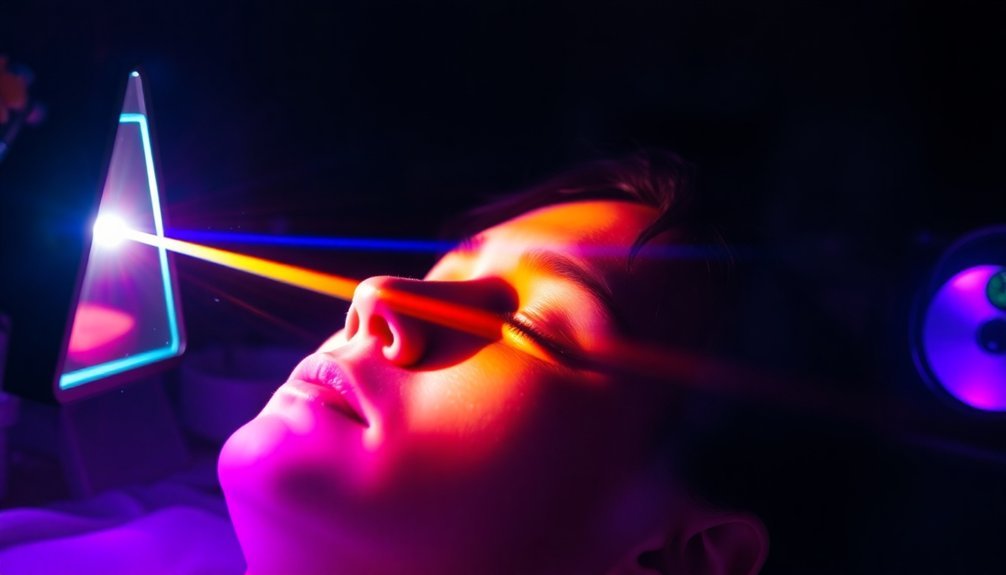
Three key factors shape how light influences your sleep patterns: the type of light you're exposed to, when you encounter it, and your body's biological response. Your body's internal clock, regulated by the suprachiasmatic nucleus, responds distinctly to different wavelengths of light, with blue light having the most powerful impact on your sleep-wake cycle.
When you're exposed to blue light, particularly from electronic devices or LED lighting, your body suppresses melatonin production more intensely than with other light types. This suppression can shift your circadian rhythms by twice as much as green light, potentially disrupting your natural sleep patterns. Even exposure to light levels as low as 8 lux intensity can disrupt your sleep cycle.
Your body's homeostatic drive naturally increases your need for sleep the longer you're awake, but exposure to artificial light can interfere with this process.
You'll find that indoor lighting, especially at night, substantially affects your sleep quality. While blue light disrupts your sleep-wake cycle, dim red light proves safer as a nightlight option.
Your body's circadian processes, which regulate temperature and hormone production over approximately 24-hour cycles, depend on proper light exposure to maintain healthy sleep patterns.
The Science Behind Red Light
Red light stands out as a scientifically-proven solution for better sleep, contrasting sharply with the disruptive effects of blue light. Unlike its blue counterpart, red light works with your body's natural rhythms, stimulating melatonin production rather than suppressing it. This makes it a powerful tool for enhancing your sleep quality and supporting your circadian rhythm.
When you're exposed to specific red wavelengths, your body responds by increasing melatonin levels, which can help you fall asleep more easily and maintain better sleep patterns. The analgesic properties of red light therapy can help reduce pain and discomfort that might otherwise keep you awake at night.
You'll find that red light therapy doesn't just improve your sleep – it can also boost your athletic endurance, reduce inflammation, and help manage stress levels by lowering cortisol.
To harness these benefits, you'll want to choose dim red lighting for your evening activities. Make sure you're using products that emit the correct red wavelengths, not just red-tinted bulbs. While bright red light can still suppress melatonin, dim red light provides the perfect balance for nighttime use.
For ideal results, combine red light exposure with good sleep hygiene practices and avoid blue light from electronic devices before bedtime.
Circadian Rhythms And Light Exposure
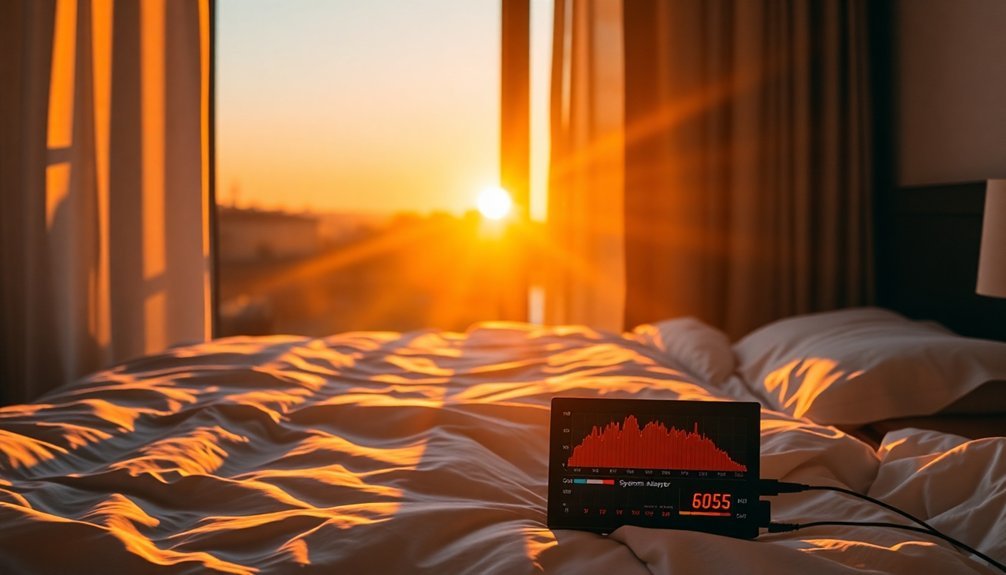
Your circadian rhythm responds powerfully to natural light exposure throughout the day, with morning sunlight being especially essential for setting your internal clock.
When you don't receive adequate natural light at the right times, your body's natural rhythms can fall out of sync, leading to sleep problems and decreased daytime alertness. The unique blue to yellow ratio in morning sunlight provides a crucial wake-up signal to your body.
Getting outside within an hour of waking and maintaining consistent light exposure patterns will help you maintain healthy sleep-wake cycles and optimize your body's natural rhythm.
Natural Light Timing Matters
Natural light plays a pivotal role in regulating your body's circadian rhythm – the internal clock that controls your sleep-wake cycle.
Your body's natural rhythm runs slightly longer than 24 hours, making it essential to reset your internal clock daily through proper light exposure. Morning sunlight, with its unique blue-to-yellow light ratio, serves as your body's most powerful synchronization signal. Environmental factors called zeitgebers such as light help fine-tune this daily adjustment process.
You'll want to pay special attention to these critical timing factors for ideal circadian health:
- Get bright light exposure within the first hour of waking – outdoor light is up to ten times more intense than indoor lighting, making it considerably more effective at regulating your body clock.
- Limit light exposure 2 hours before bedtime, when your circadian system is most sensitive to disruption.
- Keep lights dim during any nighttime awakenings to protect your sleep cycle and make it easier to fall back asleep.
When Rhythms Get Disrupted
Ever wonder why you feel completely off-kilter after pulling an all-nighter or adjusting to a new time zone? Your circadian clock is highly sensitive to disruptions, and when you break its natural rhythm, you'll experience more than just sleep issues.
When you expose yourself to bright light, especially blue wavelengths, at the wrong times, you're fundamentally sending conflicting signals to your internal clock. Even dim light as low as 8 lux can interfere with your melatonin production, and blue light exposure at night can shift your rhythm twice as much as green light. Studies show that wearing blue light blocking glasses can help preserve your normal overnight melatonin levels.
You'll notice this disruption manifests beyond poor sleep – it affects your mental clarity and overall cognitive performance.
The timing of light exposure is vital. Your circadian pacemaker is most responsive during morning and evening hours. While bright morning light advances your rhythm (helping you wake up earlier), evening light delays it (making you stay up later).
If you're experiencing disruption, you can reset your rhythm by avoiding bright light 2 hours before bedtime, dimming your evening lights, and getting ample morning light exposure. These adjustments will help realign your natural sleep-wake cycle.
Benefits Of Infrared Light Therapy
While traditional sleep remedies often fall short, infrared light therapy has emerged as a scientifically-backed solution for better sleep quality and overall well-being. When you expose yourself to infrared light before bedtime, you'll experience reduced sleep latency and increased total sleep time – adding an average of 34 minutes to your nightly rest.
This therapy works by synchronizing your circadian rhythms and stimulating natural melatonin production. Red light therapy achieves these benefits through cellular ATP production, which energizes and optimizes your body's natural sleep processes.
Clinical research has consistently demonstrated three primary benefits:
- Sleep Enhancement: You'll fall asleep faster, stay asleep longer, and wake up feeling more refreshed, with marked improvements in your sleep-wake cycles.
- Pain Management: The therapy reduces discomfort from conditions like restless leg syndrome while boosting endorphin production for natural pain relief and improved circulation.
- Stress Reduction: Unlike stimulating blue light, infrared light acts as a calming agent, helping you relax naturally and prepare for restful sleep.
You'll find that regular exposure to infrared light therapy not only improves your nighttime rest but also enhances your daytime function and energy levels. It's a safe, effective approach that addresses both the symptoms and underlying causes of poor sleep quality.
Optimal Wavelengths For Better Sleep
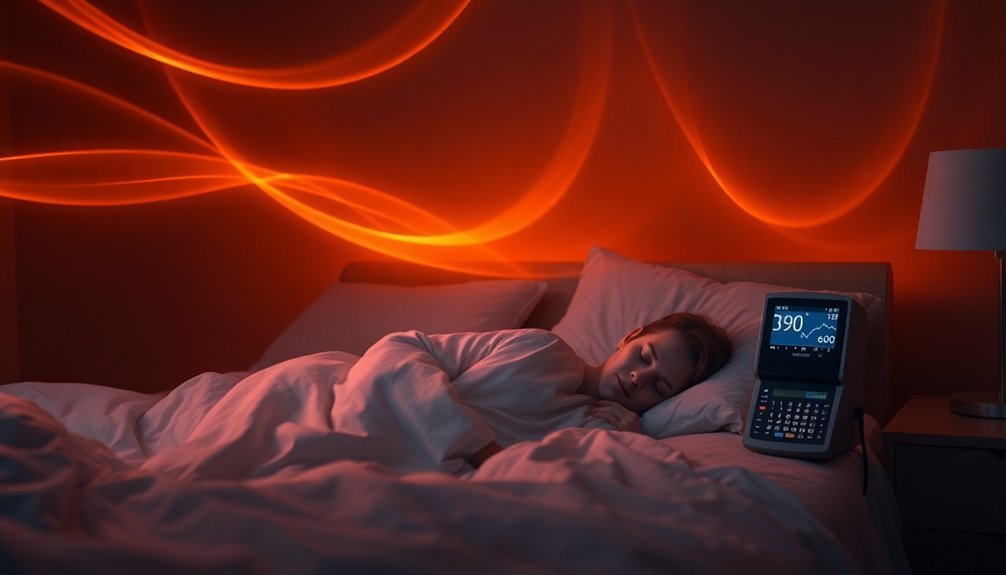
Your body's melatonin production responds strongly to specific light wavelengths, with red light (660 NM) promoting better sleep while blue light (450-495 NM) disrupts your natural sleep patterns.
You'll find that using blue light blocking glasses or limiting screen exposure in the evening can help maintain healthy melatonin levels and improve your sleep quality. Natural daylight exposure during daytime hours helps synchronize your sleep-wake cycle with Earth's natural rhythm.
Understanding how natural light patterns affect your circadian rhythm lets you make informed choices about evening lighting, whether that's switching to red light therapy or adjusting your device settings to reduce blue light exposure.
Wavelength Impact On Melatonin
Understanding specific wavelengths' impact on melatonin production is essential for optimizing your sleep quality. Research shows that wavelengths between 460-500 nm substantially suppress your melatonin production, making it harder for you to fall asleep.
When you're exposed to these shorter wavelengths, particularly blue light around 470 nm, you'll experience decreased melatonin levels and increased wakefulness. Modern research demonstrates that using evening-optimized LEDs can increase nighttime melatonin levels by 12.2% compared to conventional lighting.
However, not all wavelengths disrupt your sleep hormone. Longer wavelengths, such as 595 nm and 660 nm, won't interfere with your melatonin production. You'll maintain healthy melatonin levels by focusing on light exposure that excludes wavelengths below 530 nm, especially during evening hours.
To protect your melatonin production and maintain healthy sleep patterns:
- Limit your exposure to short-wavelength light (460-500 nm) in the evening
- Choose lighting solutions that utilize wavelengths near 450 nm, which won't substantially suppress melatonin
- Use light filters that block wavelengths below 530 nm when you need illumination at night.
Blue Light Blocking Benefits
Building on our knowledge of wavelength impacts, blocking blue light offers a powerful solution for protecting your natural melatonin production and sleep cycle.
Research shows that wearing blue light blocking glasses, particularly those targeting the 400-450 nm range, can substantially improve your sleep quality and reduce the time it takes you to fall asleep.
You'll experience the most benefits when you wear these glasses 2-3 hours before bedtime. The amber or orange-tinted lenses effectively block the wavelengths that typically suppress your melatonin production, allowing your body to maintain its natural circadian rhythm. This intervention is especially valuable if you're exposed to screens or artificial lighting in the evening hours.
Clinical studies demonstrate that you won't just sleep better – you'll also likely notice improvements in your processing speed and short-term memory. The benefits extend beyond basic sleep metrics, as many users report enhanced mood and fewer sleep interruptions throughout the night.
If you're dealing with irregular sleep schedules due to shift work or jet lag, you'll find these glasses particularly beneficial in regulating your sleep-wake cycle and improving overall sleep efficiency.
Natural Light Sleep Patterns
Natural light serves as the body's most powerful timekeeper, orchestrating your sleep-wake cycles through specific wavelengths that signal when to be alert and when to rest.
Your body's circadian rhythm responds most strongly to natural light exposure during key times of the day, particularly in the morning and at midday when sunlight is brightest.
To enhance your sleep patterns through natural light exposure, you'll want to follow these essential timing guidelines:
- Get bright light exposure within one hour of waking up to boost alertness and regulate your biological clock
- Maximize midday sun exposure, as it's proven more effective than morning light for improving sleep quality
- Avoid bright light exposure two hours before bedtime to support your body's natural melatonin production
You can substantially improve your sleep quality by maintaining consistent daily light exposure patterns. If you're experiencing sleep difficulties, especially during winter months, increasing your daytime exposure to natural light can help prevent circadian disruption and seasonal affective disorder.
When you combine strategic light exposure with regular exercise and a consistent sleep schedule, you're setting yourself up for ideal sleep-wake patterns.
Nighttime Light Management Strategies
Effective nighttime light management plays a crucial role in maintaining healthy sleep patterns. To protect your melatonin production, you'll need to turn off electronic devices at least an hour before bedtime. If you must use screens, install blue light filtering apps or wear specialized glasses to minimize disruption to your sleep cycle.
Your bedroom environment requires particular attention. Install blackout curtains to block external light sources, and use dimmable LED bulbs to control indoor lighting levels. Even exposure to light as low as 3 lux can suppress melatonin, so create a genuinely dark sleeping space.
When you need to navigate at night, use dim red lights, which have minimal impact on your sleep hormones.
Create a gradual shift to bedtime by slowly dimming lights throughout your evening. Replace bright reading lights with non-backlit sources, and maintain darkness even during daytime naps.
If you're struggling with your sleep-wake cycle, consider using a wake-up light that simulates sunrise in the morning. Remember to keep your bedroom cool, around 60-67 degrees Fahrenheit, as this temperature range supports ideal melatonin production.
Red Light Vs Blue Light
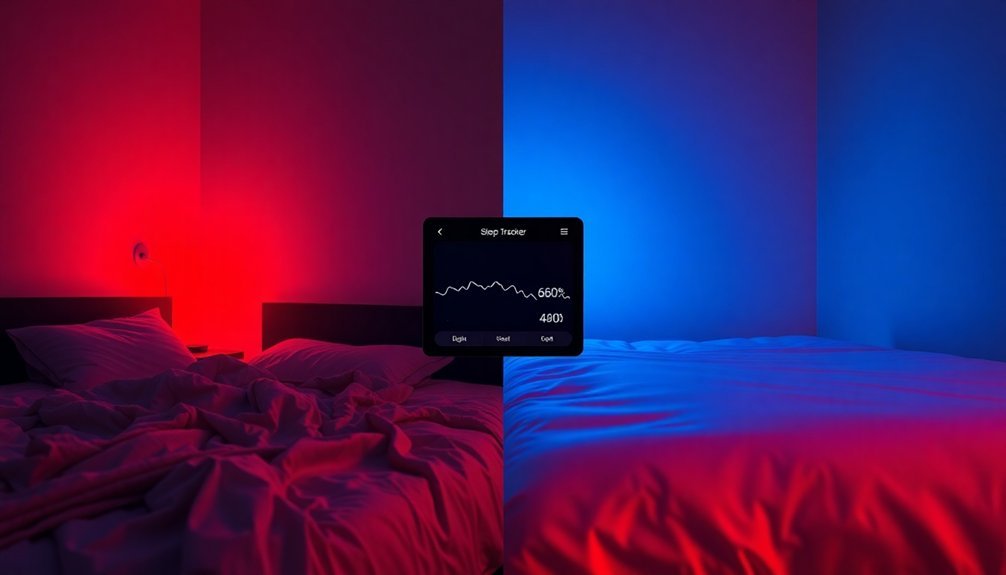
Light's impact on sleep varies dramatically between wavelengths, with red and blue light producing opposite effects on our bodies. While red light stimulates melatonin production and promotes sleepiness, blue light does the exact opposite by suppressing melatonin and increasing alertness.
Your electronic devices primarily emit blue light, which can seriously disrupt your natural sleep patterns.
The differences between these wavelengths are stark and scientifically proven. Red light mimics sunset, helping you wind down naturally, while blue light tricks your body into thinking it's still daytime. You'll find that red light also supports muscle regeneration and maintains your night vision, making it ideal for evening activities.
Here's what you need to know about managing these wavelengths:
- Switch to red lighting in your bedroom at least 2 hours before sleep
- Use blue light blocking glasses when using electronic devices after sunset
- Replace bright white nighttime lighting with red alternatives to protect your circadian rhythm
Studies consistently show that making these adjustments can markedly improve your sleep quality and duration. If you're struggling with sleep, controlling your exposure to these different wavelengths could be the key to better rest.
Sleep Enhancement Through Light Control
To optimize your sleep environment, start by reducing your exposure to blue light at least 2.2 hours before bedtime. If you must use electronic devices, wear amber or orange-tinted glasses to filter out sleep-disrupting wavelengths.
You can also adjust your devices' color temperature settings to warmer tones, which helps maintain your body's natural melatonin production.
Consider replacing traditional lighting with circadian-friendly alternatives that match the natural daylight spectrum. Red light is particularly effective for evening use, as it won't interfere with your sleep-wake cycle.
By synchronizing your daily activities with your natural circadian rhythm and maintaining consistent sleep schedules, you'll enhance your sleep quality substantially.
Remember to create an environment that minimizes light disturbances, especially during your designated sleep hours, to support your body's homeostatic balance.
Natural Sleep Patterns Restored
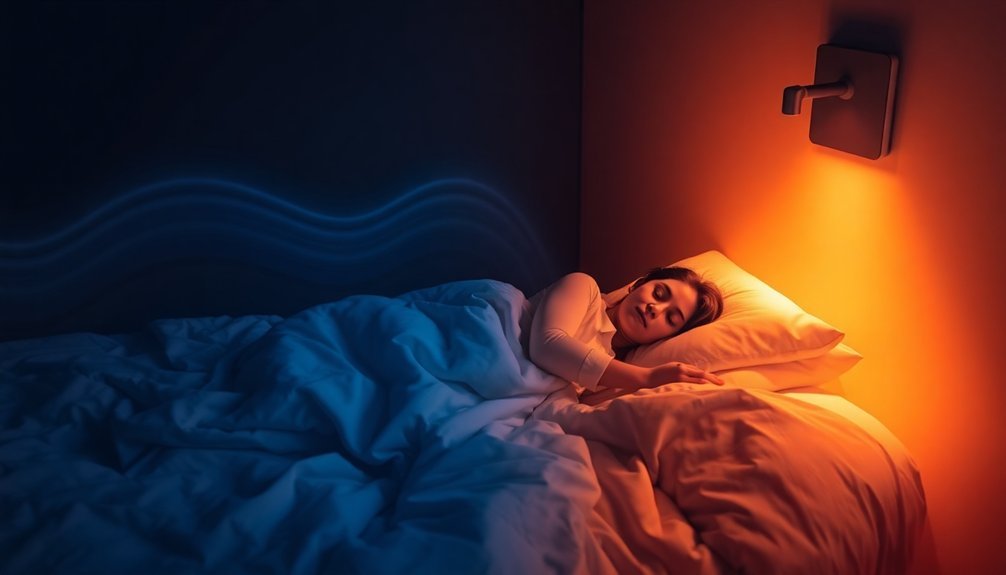
Your body's natural melatonin release cycle responds to specific wavelengths of light, with blue light suppressing production and warmer, amber tones allowing its natural flow.
You'll find your sleep-wake rhythm improves when you match your light exposure to your body's innate 24-hour cycle, particularly by getting bright morning light and dimming artificial lights in the evening.
You can reset your body clock through consistent exposure patterns that align with your natural circadian rhythm, including strategic use of light therapy and darkness to strengthen your sleep-wake signals.
Melatonin's Natural Release Cycle
During the night, melatonin orchestrates your body's natural sleep rhythm through a precisely timed release cycle. Your pineal gland releases melatonin in pulses as darkness falls, with levels gradually rising until they peak between 3 and 4 am.
This natural process begins when light signals from your retina decrease, triggering your suprachiasmatic nucleus to activate melatonin production.
Your body's melatonin production follows three key phases:
- Initial Release: As evening approaches and light dims, your pineal gland converts serotonin to melatonin through the enzyme AA-NAT, starting the release cycle.
- Peak Production: Your melatonin levels steadily increase throughout the night, reaching their highest concentration in the early morning hours.
- Morning Decline: As daylight approaches, light signals suppress melatonin production, helping you naturally wake up.
Understanding this cycle is essential because it's intimately connected to your sleep-wake patterns. When you're exposed to artificial light at night, you're disrupting this delicate process.
Your pineal gland's ability to produce melatonin depends on proper darkness signals, which is why maintaining a consistent light-dark environment supports your natural sleep rhythm.
Sleep-Wake Rhythm Optimization
Restoring natural sleep patterns requires a thorough approach that aligns your daily activities with your body's internal clock. You'll need to focus on both morning and evening routines to enhance your sleep-wake rhythm effectively.
Start by exposing yourself to natural sunlight for at least 20 minutes shortly after waking. If you can't access natural light, use a bright light therapy lamp as an alternative. In the evening, you'll want to dim your lights and avoid blue light from electronic devices at least two hours before bed.
| Time of Day | Do This | Avoid This |
|---|---|---|
| Morning | Get sunlight exposure | Staying in dark rooms |
| Afternoon | Exercise and balanced meals | Heavy meals, caffeine |
| Evening | Dim lights, relaxation | Screens, intense activity |
Maintain consistent meal times and exercise schedules during daylight hours, avoiding vigorous workouts close to bedtime. Create a sleep-conducive environment by keeping your bedroom dark, quiet, and cool. If you need to adjust your sleep schedule, make gradual changes of 15-30 minutes per day rather than dramatic shifts. Remember that consistency is key – maintain your sleep-wake schedule even on weekends for ideal results.
Body Clock Reset Methods
Resetting the body clock requires a systematic approach combining multiple evidence-based methods. You'll find success by creating an environment that supports your natural circadian rhythm while implementing consistent daily routines.
Start by blocking out all light in your bedroom and maintaining a cool temperature, as these environmental factors substantially influence your sleep-wake cycle.
To naturally reset your internal clock, follow these key strategies:
- Expose yourself to bright sunlight within the first hour of waking, while cutting back on blue light exposure in the evening – opt for dim red lights instead.
- Stick to a consistent sleep schedule every day, including weekends, and avoid naps that might disrupt your nighttime sleep pattern.
- Time your exercise properly by completing workouts at least 3-4 hours before bedtime, and consider gentler evening activities like yoga or meditation.
You can enhance these methods with natural aids like melatonin supplements (under medical supervision), aromatherapy with lavender, or mindfulness practices.
Body Temperature And Light Exposure
The complex relationship between light exposure and body temperature plays a vital role in your sleep-wake cycle.
When you're exposed to light at night, your body temperature rises unexpectedly, disrupting your natural cooling process that typically occurs during sleep. This happens because light suppresses melatonin, your sleep hormone, which normally helps regulate your body temperature.
Your environment's temperature also influences how light affects you. In cooler rooms, your core temperature increases while your skin temperature drops.
When you're exposed to bright light in the morning, you'll experience decreased cortisol levels and core body temperature, which helps maintain your natural circadian rhythm.
You'll get the strongest circadian benefits from natural outdoor light, which is up to ten times brighter than indoor lighting. Morning sunlight is particularly effective due to its unique blue-to-yellow light ratio, acting as a powerful wake-up signal for your body.
However, you'll want to avoid bright light, especially blue light, in the evening hours. This late exposure can disrupt your melatonin production, elevate your body temperature, and interfere with your sleep quality.
Implementing Light Therapy At Home

Successfully implementing light therapy at home requires understanding both the essential equipment and ideal timing for your sessions. You'll need to choose from various device options, including LED masks, panels, or portable units, depending on your specific needs and comfort preferences. These devices offer flexibility in usage and eliminate the recurring costs of clinical visits.
To maximize your home light therapy's effectiveness, you'll want to follow these key steps:
- Set up your therapy space in a comfortable area where you won't be disturbed, ensuring you have proper power access and room to position your device correctly.
- Remove any barriers between your skin and the light source, though you'll need appropriate eye protection during sessions.
- Position your device at the recommended distance and angle, which varies based on the specific type of light therapy unit you're using.
You can create a personalized treatment schedule that fits your daily routine, as home devices allow for consistent, long-term use.
Research shows that higher light intensities often produce better results, particularly for sleep-related issues, so you'll want to maintain proper positioning throughout each session.
Frequently Asked Questions
Can Wearing Prescription Glasses Affect How Blue Light Impacts Sleep Quality?
Your prescription glasses can impact blue light's effect on sleep, especially if they've got blue light filtering coatings. However, the effectiveness varies based on coating quality and specific wavelengths they're designed to block.
Does Blue Light From Natural Sources Like Sunsets Affect Sleep Differently?
Natural blue light from sunsets won't disrupt your sleep like artificial sources. It's part of your body's natural light cycle, helping signal when it's time to wind down and prepare for rest.
How Do Seasonal Changes in Daylight Affect Our Sensitivity to Blue Light?
You're more sensitive to blue light during winter months when daylight is scarce. Your body responds more strongly to light exposure then, while in summer, with abundant daylight, you're naturally less sensitive.
Can Certain Medications Alter Our Response to Sleep-Disrupting Wavelengths of Light?
Yes, your medications can substantially change how light affects your sleep. Beta-blockers, SSRIs, and antidepressants can make you more sensitive to blue light, while melatonin supplements and orexin antagonists can help counter these effects.
Does Eye Color Influence How Different Light Wavelengths Affect Sleep Patterns?
Your eye color doesn't affect how light wavelengths impact your sleep patterns. Research shows that blue light suppresses melatonin and disrupts sleep equally for everyone, regardless of whether you have blue, brown, or green eyes.
In Summary
You've now discovered how specific wavelengths of light can transform your sleep quality. By implementing red and infrared light therapy while controlling your exposure to blue light, you'll reset your natural circadian rhythms. Start with small changes in your evening routine, and you'll soon experience deeper, more restorative sleep. Don't wait – take control of your light environment tonight for better sleep tomorrow.

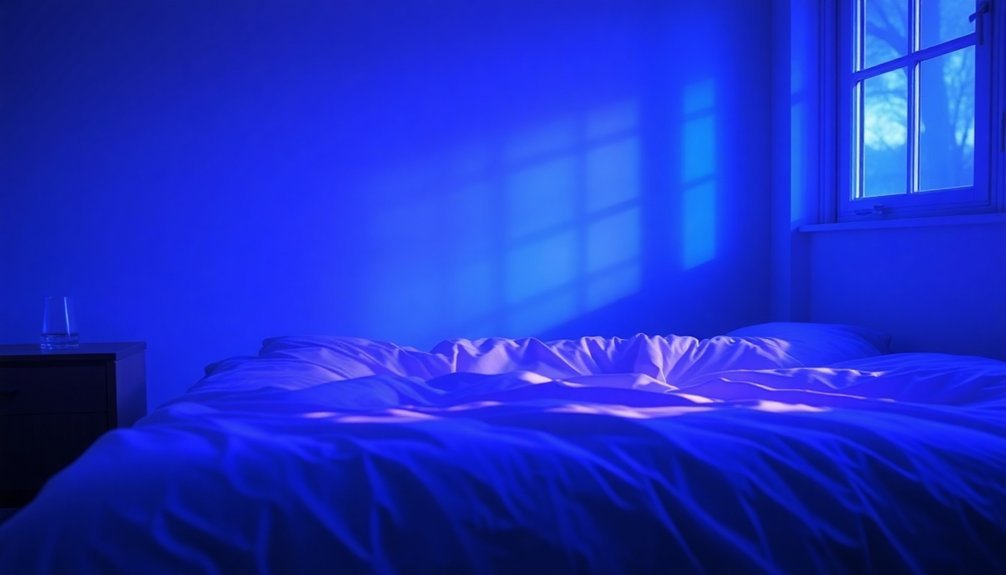



Leave a Reply